
A Complete Product Development Outsourcing Guide
Product development outsourcing is a popular business strategy, with 74% of companies worldwide already outsourcing their IT processes. It enables businesses to reduce costs, speed up time-to-market, and access specialized skills and resources. Yet, outsourcing product development has its pitfalls. Thus, it requires careful planning, management, and execution.
So how can you overcome those issues and delegate your product development tasks right? Find the answers to this question in Artkai’s comprehensive guide to product development outsourcing. We’ll cover the benefits of outsourcing, in-house vs. outsourced software product development, the step-by-step outsourcing process, and more.
Artkai will also share its extensive expertise in product development, taking some of our projects like Coіnloan, Cruitment, Huobi, ProCredit, Nezha, and DTEK as examples. Discover practical insights on outsourcing backed up with our seven-year background in the business.
How Product Development Outsourcing Can Help a Product Owner
Product owners face numerous challenges when developing software. They include managing scope, time, and resources, ensuring quality, and meeting user needs. Product development outsourcing can help them tackle these issues by providing access to technical and business expertise, lowering development costs, and speeding up market launch.
In this product development outsourcing guide, we’ll highlight other benefits of this cooperation model. Those include increased scalability since product owners can engage an outsourcing vendor effortlessly, the flexibility of processes, and the ability to focus on core business tasks.
In-House vs. Outsourced Software Product Development: Which Is More Lucrative for You?
Choosing between in-house and outsourced software product development depends on various factors, some of which include the following:
- Product owner’s budget
- Project scope and complexity
- Project timeline
- Level of expertise and resources required
Let’s now look at these two cooperation models in greater detail.
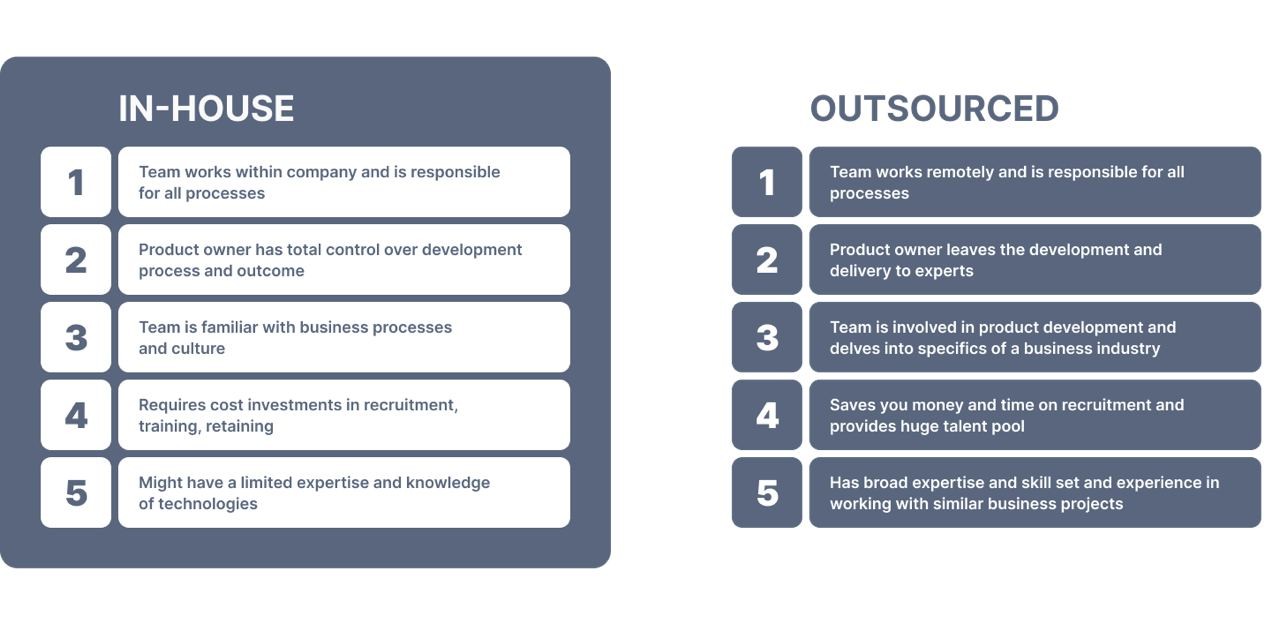
In-House Software Product Development
It refers to a team of engineers who work within the company to build the product. The product owner retains complete control over the process, including the design, implementation, and testing phases. In-house dev teams are usually more familiar with the company’s business operations and culture, which can lead to a better understanding of the product requirements.
Outsourced software product development
It involves hiring an external dev team or software development company. This approach allows the product owner to focus on their core competencies while leaving the development process to the experts. Outsourced development teams typically have profound expertise, which can be advantageous in complex projects.
There is no straightforward answer regarding lucrativeness, as it depends on your specific business needs and goals.
If you need to work closely with your developers, in-house teams are your option. Yet, they can be more expensive and require significant investment in infrastructure and resources. In contrast, product development outsourcing may offer more flexibility and cost savings, but you’ll have to manage the dev processes remotely.
Thus, carefully evaluating the project’s scope, budget, timeline, and required resources can help determine which approach is more profitable in the long run.
Benefits of Product Development Outsourcing
Product development outsourcing can be an excellent solution for a product owner looking to develop a software product. Here are some of the benefits that it can offer:
Extensive Talent Pool
Product owners can tap into a global talent pool, including software engineers, designers, business analysts, and project managers, when outsourcing product development. They can quickly locate and hire any specialist they require.
Profound Expertise
This cooperation model also allows businesses to benefit from the experience and best practices of the outsourcing partner, who can provide insights into the latest technologies, market trends, and user requirements.
Reduced Expenses
Product development outsourcing reduces expenses, as outsourcing vendors can provide services at a lower cost than hiring in-house staff. This cooperation model doesn’t require retaining employees and covering other operational expenditures.
Fast Scaling
This work approach also enables product owners to scale their development teams up or down as necessary. When outsourcing, businesses don’t have to worry about the overhead costs of hiring, training, and managing staff.
Sped Up Time-to-Market
Finally, product development outsourcing can help product owners speed up time-to-market, as remote vendors can leverage their expertise, resources, and processes to accelerate product development cycles. Outsourcing partners can also assist product owners in reducing risks by providing testing, quality assurance, and compliance services before market launch.
All in all, product development outsourcing can help product owners create high-quality software more quickly and cost-effectively while allowing them to concentrate on their main business processes. Yet, choosing the right outsourcing partner is critical as the project deliveries highly depend on their expertise and skills.
Artkai’s Expertise in Product Development Outsourcing
Artkai is a product development outsourcing company helping businesses design, develop, and launch software products that meet their unique needs and goals. With our unique Artkai Product Validation Sprint™, product design and development services you'll build applications that fit the market and enamor customers.
With over seven years in the industry, we have successfully delivered over 100 projects, some of which include the following:
Internet Banking Application for ProCredit Georgia
Our client, ProCredit Georgia, aimed to digitize their banking services to reduce their internal staff workload. ProCredit also wanted to grant its customers access to new online services through a user-friendly web and mobile app.
This project required a team of 2 UI/UX designers, 3 front-end engineers, a project manager, a business analyst, and a QA specialist. Our experts dedicated 4.5 months to research and design and 7 months to deliver development and QA services.
We delivered a web banking platform with a dashboard and fast access navigation and a mobile banking app with smooth onboarding, a My Finances section, and smart login features. As a result of our work, ProCredit Georgia achieved the following outcomes:
- 99% of banking services went online
- 1,5x faster online transfers
- 60% faster card-blocking speed through a mobile app
- 2x faster mobile app login

Web-Based P2P Lending Platform and Marketing Website Coіnloan
Our client, Coinloan, the first crypto-to-fiat lending platform with marketplace opportunities, aimed to build a secure, transparent, and user-friendly P2P web-based platform to attract crypto enthusiasts and FinTech experts. Coinloan also wanted to promote its product through an engaging marketing website.
Our team for this project comprised 2 UI/UX designers, 2 front-end engineers, a QA specialist, a project manager, and a business analyst. We dedicated two months to research and design processes and four months to development and quality assurance.
Our experts determined the project goals, requirements, and KPIs during the research and planning stage. After that, we enabled the following web platform functionality: KYC and AML, withdrawing or depositing fiat/crypto assets, making payments, and getting loans. As for the marketing website, our specialists created separate flows for different user types and ensured powerful visual communication.
As a result, we delivered a platform with top-notch UX with over 100,000 active users.
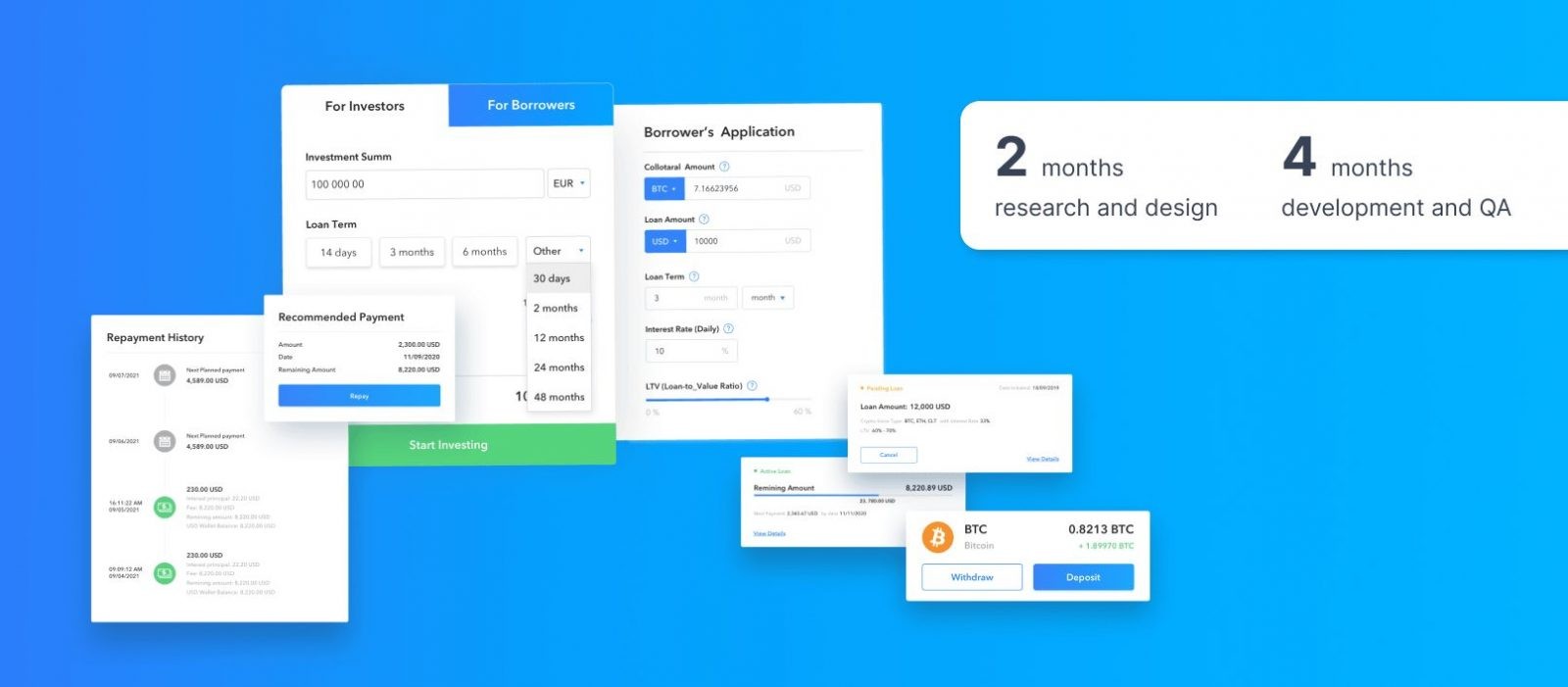
HR & Recruitment SaaS Platform Cruitment
Cruitment, a SaaS platform streamlining HR and recruitment processes, needed a new visual identity. Our client also wanted their platform to serve two user flows, namely for recruiters and job-seekers.
Our team consisted of an art Director, a UI/UX designer, 2 front-end engineers, 2 back-end engineers, a solutions architect, a DevOps specialist, a QA engineer, a project manager, and a business analyst. These experts spent 2.5 months on research and design and six months on product development and QA.
We started our work by building the app structure covering the user’s pain points and needs. Our experts implemented separate functionalities for recruiters (Kanban board, pins, customizable reports, notifications, etc.) and candidates (job search, submitting interview applications, and feedback review). We also created a brand identity for the Cruitment platform from scratch.
As a result, Cruitment gained the following outcomes:
- 3x larger candidate pool
- 2x more accepted offers
- 1.5x reduced cost per applicant
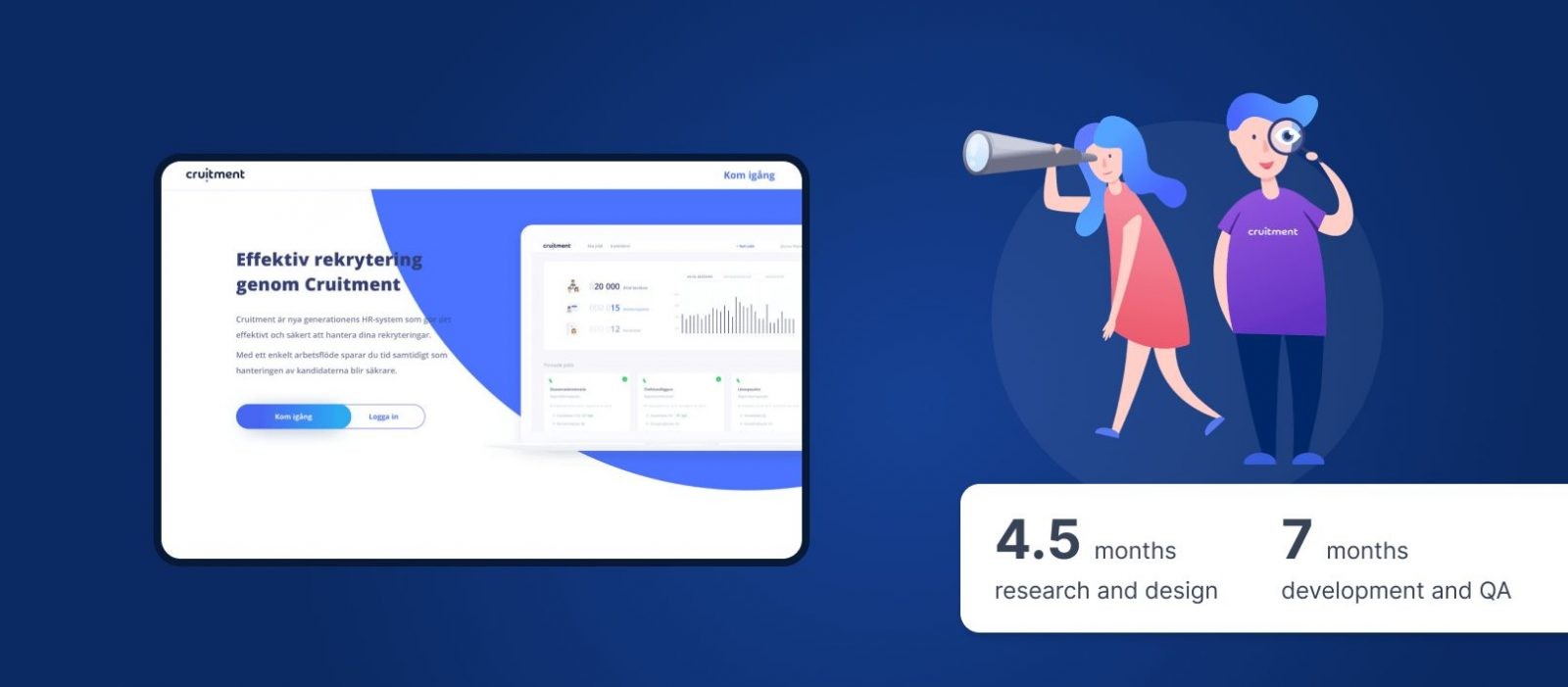
Mobile Trading Platform Huobi
Our client, the leading blockchain company Huobi Group, required us to research the European market and find user pain points and particular UX patterns. We also had to deliver a better user experience and develop a marketing website for a European market.
Our team for this project comprised 2 UI/UX designers, a project manager, and a business analyst. Our experts studied the European market and derived valuable insights on UX improvements. We created a design system and implemented the following features: an intuitive interface, user control, quick access, and secure storage. We also delivered a marketing website.
As a result, Huobi gained:
- $1,2 trillion of accumulative turnover
- 50% of global share digital asset
- Numerous new users in 130 countries
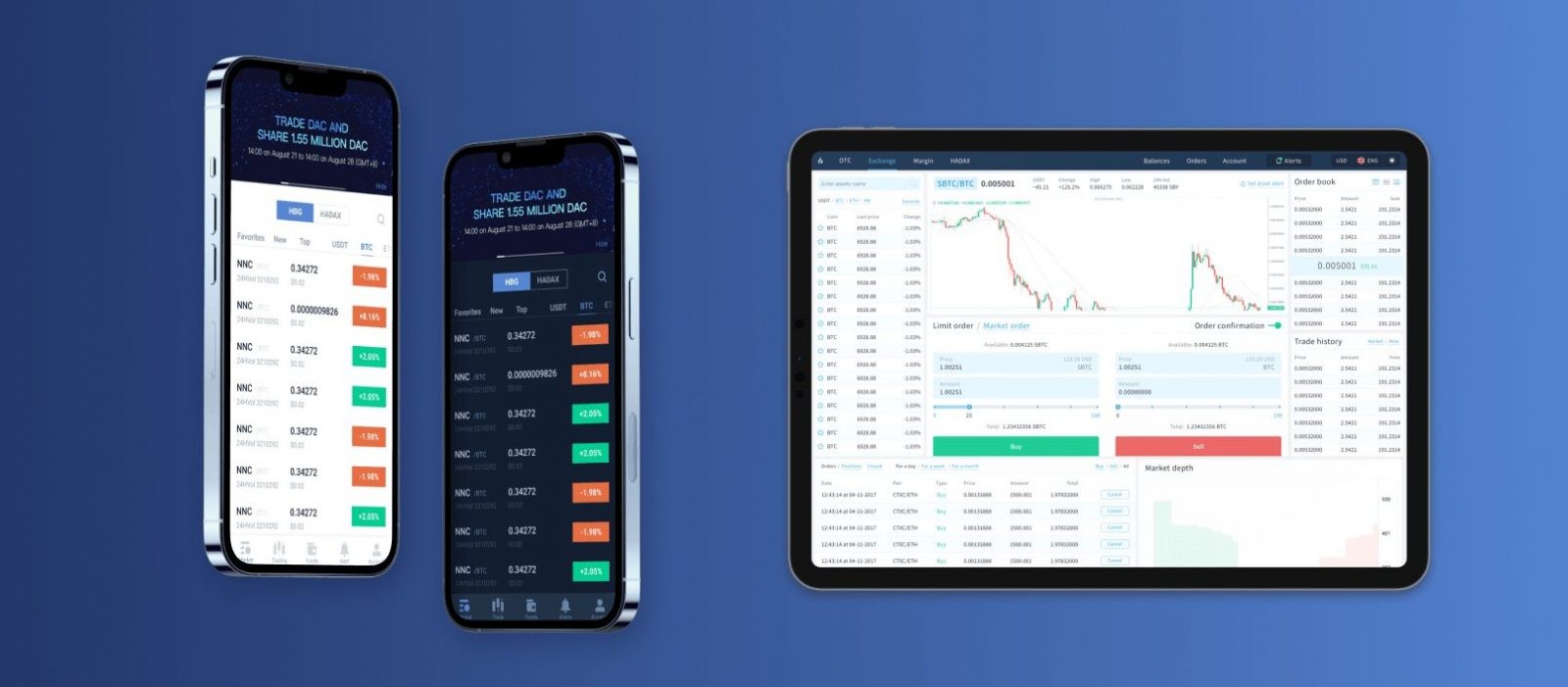
Blockchain Prediction Market Protocol Nezha
Nezha, a liquidity engine, aimed to build a web-based blockchain prediction market protocol, attract new users, and make their product engaging.
This project required a large team of 2 UI/UX designers, 2 front-end engineers, 2 back-end engineers, 2 blockchain engineers, a solutions architect, a DevOps specialist, a QA engineer, a project manager, and a business analyst. These experts spent three months on research and design tasks and about seven months on development and QA.
We started with personas and CJM identification, architecture and smart contract flow creation, and front-end, back-end, and blockchain development. We enabled the following features: user ID verification, profile pages, direct wallet connection, Solana NFT, and a blog. Our experts also provided a gamified UI/UX design and striking visual identity.
As a result, Nezha could optimize its business processes and retain more users with a complex solution, offering intuitive navigation.
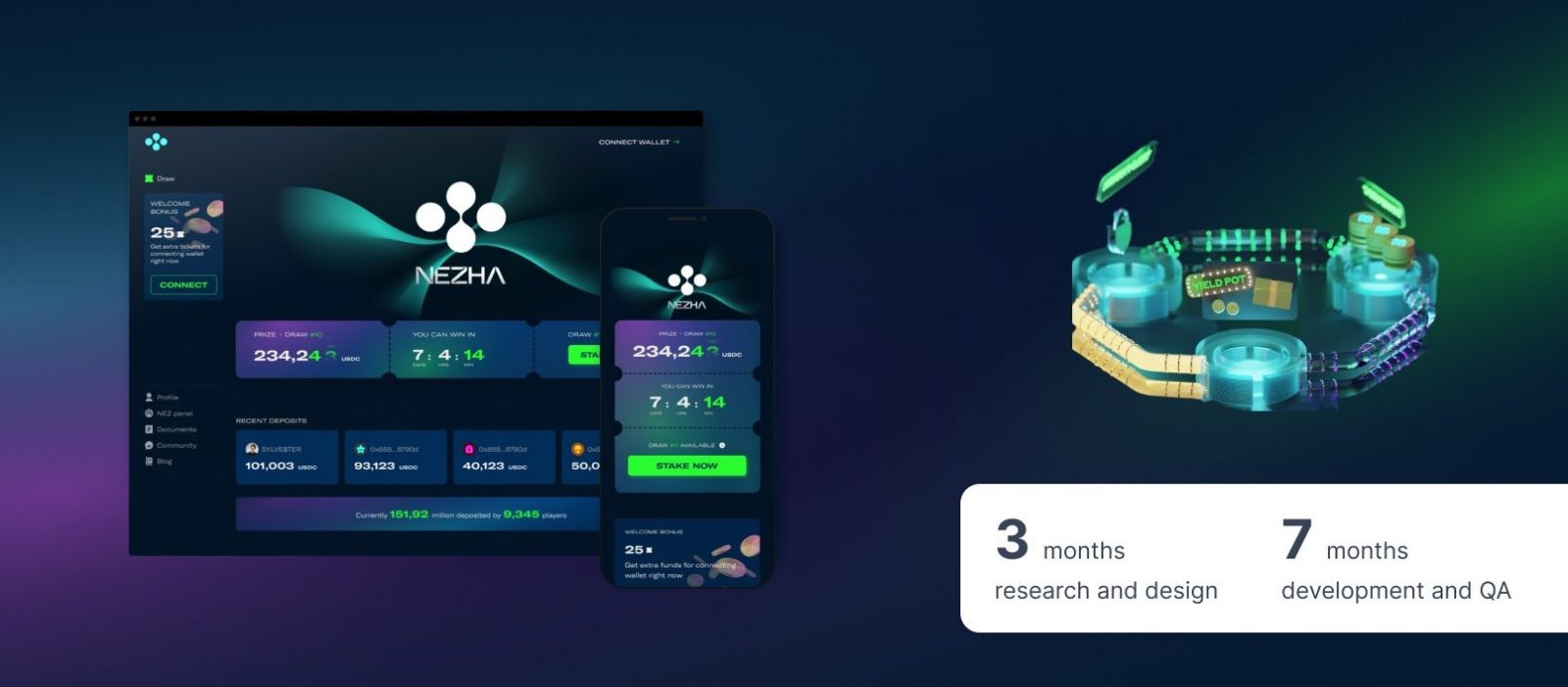
Digital Transformation for Energy Sector Enterprise DTEK
DTEK, a Ukrainian energy distribution system, demanded the Artkai team streamline their digital transformation. We had to build an online customer portal, ensure top-notch security, improve customer experience, and automate operations.
Our team for this project consisted of 2 UI/UX designers, 3 front-end engineers, 3 back-end engineers, an SAP WebServices engineer, a solutions architect, a DevOps expert, 2 QA engineers, a project manager, and a business analyst. We dedicated 4 months to research and design and about a year to development and QA processes.
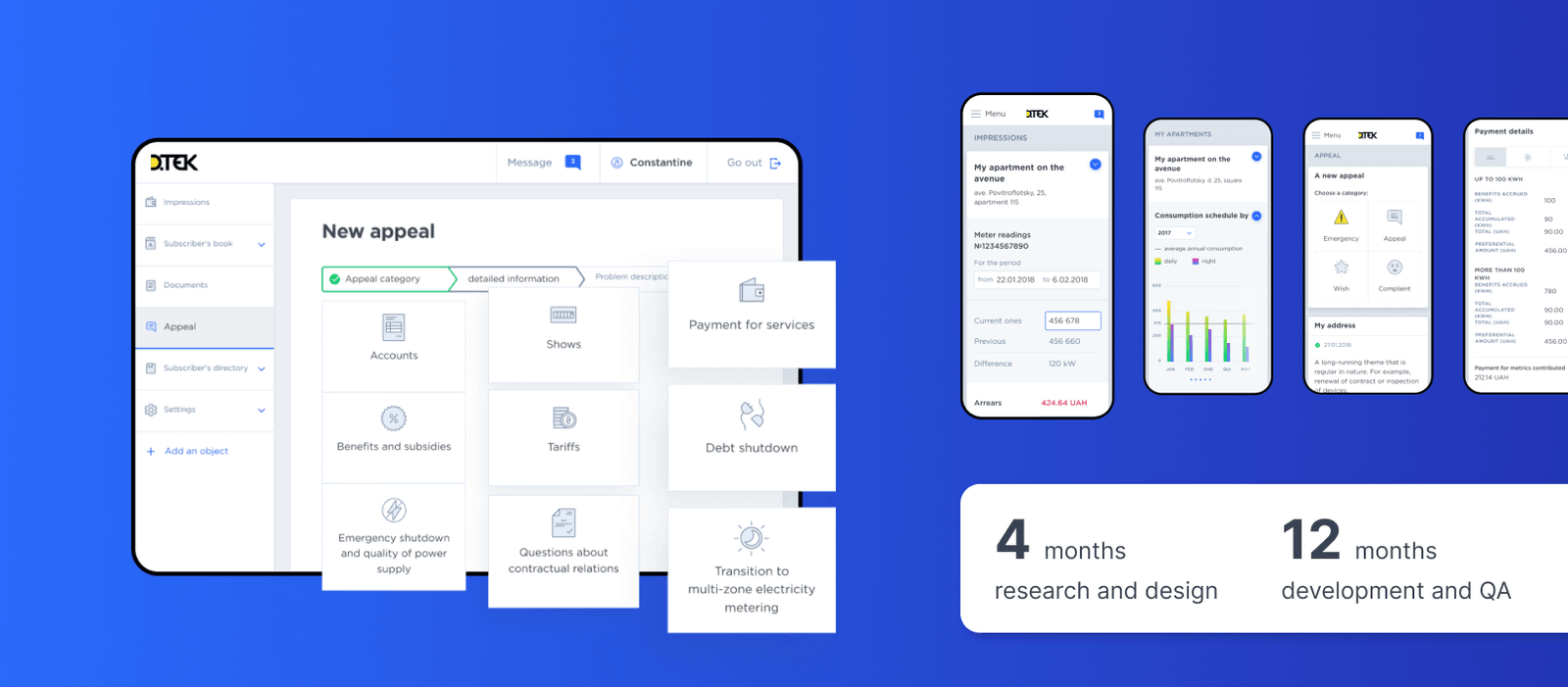
We built a solution architecture following DTEK’s requirements and delivered a platform featuring payment history, billing and payment, energy management, and self-service capabilities. Our experts also created a design system corresponding to the needs of users of various age groups.
As a result, our client got an increased number of concluded energy consumption contracts, reduced the number of customer requests to the support center by three times, and boosted the customer satisfaction score by 1.5 times.
Outsourcing Product Development Services to Reach Your Business Goals
Businesses can outsource almost any product development service. Here are a few examples of tasks you can delegate to an external vendor:
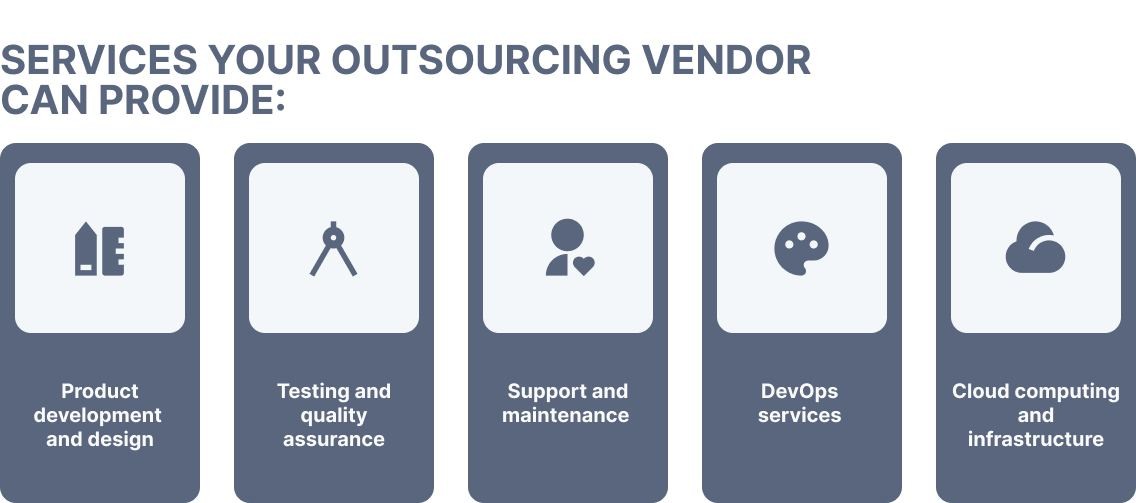
Software Development
This service may include custom software development, web and mobile app development, and more. You can hire developers with the tech skills and programming language knowledge necessary to build your product.
Product Design
This service is about designing the user interface and user experience of your software product, creating wireframes and prototypes, and conducting user research to ensure the product meets the needs of its target audience.
Testing
It involves identifying defects and bugs in the software product and reporting them to the development team. Testing services typically comprise manual testing, automated testing, and regression testing.
Quality Assurance
This service evaluates the software product to ensure it meets the specified quality standards. You may outsource functional testing, performance testing, security testing, and compatibility testing.
Maintenance and Support
These services involve ongoing support and maintenance for your software product. They aim to guarantee your product functions correctly and meets changing user needs. Maintenance and support services include bug fixing, feature enhancements, and technical support.
Cloud Computing and Infrastructure
These services may include cloud migration, server management, and infrastructure optimization to ensure your software product is scalable, secure, and efficient.
DevOps
This service involves managing software development throughout the entire life cycle. It typically includes continuous integration and deployment, automation, and monitoring to ensure the product performs well.
Step-by-Step Guide to Product Development Outsourcing
Delegating product creation tasks to a remote service provider requires thorough vendor selection to ensure the coherence of all processes. Let’s hop on our product development outsourcing guide that’ll help you streamline your software development work.
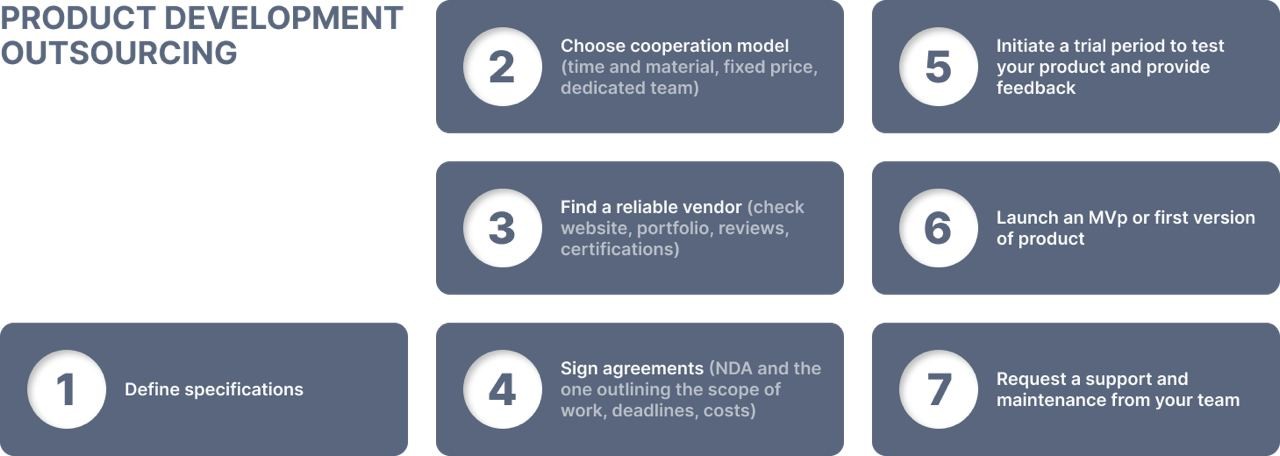
Step 1. Defining Software Specifications
The first step in product development outsourcing involves determining precise software specifications. That includes the product’s functionality, design features, and core goals. It will help you communicate your requirements to the outsourcing vendor and ensure they understand what you want.
Step 2. Choosing a Cooperation Model
There are several models of cooperation to consider. Our company, in particular, offers time and material, discovery and business analysis, and dedicated team collaborative approaches. Let’s view the most common ones in greater detail:
Time and material
This model involves paying the outsourcing vendor for the time and materials used to complete the project. The service provider charges an hourly rate for each team member working on the project, and the cost is calculated based on the number of hours. This model is suitable for projects where the scope of work is uncertain or may change during the development process.
Fixed price
This model involves agreeing on a fixed price based on the project’s scope, deliverables, and timelines. The outsourcing vendor is responsible for delivering the project within the agreed-upon budget, and any additional work is charged separately. This model is suitable for projects with a well-defined scope and a clear timeline for completion.
Dedicated team
This model involves hiring an outsourcing vendor to provide a dedicated team to work exclusively on the project. The team is responsible for delivering the project within the agreed scope and timeline, typically for a monthly or quarterly fee. It is best for projects that need ongoing development and maintenance.
Each cooperation approach has advantages and disadvantages, so choose the one that best suits your project’s requirements and budget.
Step 3. Finding a Suitable Outsourcing Vendor
Research outsourcing vendors and select the one with the expertise to deliver your tasks on time and within budget. Look for a partner with a proven track record of successful projects, positive customer feedback, and relevant certifications.
Step 4. Signing Agreements
Once you have selected an outsourcing vendor, you should sign agreements outlining the scope of work, deliverables, timelines, and costs. Ensure you have a written legal representation with all terms and conditions.
Step 5. Initiating a Trial Period
Before launching the product’s first version, it’s essential to have a trial period to test the software and ensure it meets your specifications. During this time, the vendor can make any necessary adjustments to the product, and you can provide feedback to secure the deliverables correspond to your specifications.
Step 6. Launching the Product’s First Version
Once the software has passed the trial period, it’s time to roll out its first version. Work with the outsourcing vendor to ensure the launch goes smoothly and any issues are addressed quickly.
The products you can launch at this stage may include a minimum viable product (MVP) or a simple prototype.
Step 7. Requesting Ongoing Support
Even after the product launch, it’s essential to have continuous support to ensure it remains up-to-date, secure, and functional. Work with the outsourcing vendor to establish a support plan that includes regular updates, bug fixes, and maintenance.
By following these steps, businesses can successfully set the product development outsourcing process and reach their goals immediately.
Product Development Outsourcing Costs Explained
Product development outsourcing costs can vary widely depending on the project’s scope, complexity, and location of the outsourcing vendor. Here are some factors that can impact your budget:
- Project requirements
The project’s specifications, such as the number of features, the complexity of the design, and functionality, can impact the cost of outsourcing. More complex projects may require more resources and time, increasing expenses.
- Team size and skill set
The size and skill set of the outsourcing team can also impact the cost. Hiring more experienced and skilled team members can increase the hourly rate.
- Timeframe
The project’s timeline can impact the cost of outsourcing. Tight deadlines may require additional resources and more expenses.
- Outsourcing vendor’s location
Vendors located in countries with lower labor costs may offer lower rates, while service providers in countries with higher labor costs may charge more.
- Cooperation model
Each model described above has its pricing structure and can impact the final cost.
Now that you know the price-influencing factors, let’s look at how much it costs to hire software developers in different countries.
| Outsourced Software Developer Average Rate by Region | |
| Region | Hourly Rate |
| North America | $40–$70 |
| Latin America | $5–$20 |
| Western Europe | $20–$35 |
| Eastern Europe | $15–$25 |
| Asia | $10–$20 |
Sources: Indeed, Talent.com, SalaryExpert.
Thus, carefully evaluate each factor that influences the product development outsourcing costs to ensure your project meets the budget and delivers the desired outcomes. And since every project is unique, you may require a more precise estimation — you can contact us.
How to Save Your Project Budget: Helpful Tips
Here are some tips to help save your project budget when opting for product development outsourcing:

State Your Requirements Clearly
Clearly define your project’s requirements and scope before outsourcing. It’ll help you avoid unnecessary features and functionalities that may add to the product’s cost.
Set Sensible Objectives
Set realistic and achievable objectives for the project to avoid unnecessary revisions and reworks, which can increase the project’s cost. It would also be great if you kept your outsourcing vendor up to date with the latest updates.
Ensure Openness and Communication
Maintain open communication with the outsourcing team to avoid misunderstandings and confusion, which can lead to additional expenses, project delays, and conflicts.
Plan Your Expenses in Advance
Discuss and determine every expense involved in the project upfront, such as the hourly rates, payment schedule, and additional expenditures. It’ll help you avoid surprises that can increase the project’s cost.
Place Features in Order
Prioritize the features of your product to ensure the most important ones are developed first. If you start software development with critical functionalities, you can save plenty of time and money.
Use Agile Development Methodologies
Agile development methodologies can help manage project costs by allowing regular product review and testing to ensure it meets the project’s objectives and requirements.
How to Pick a Reputable Outsourced Product Development Firm
As already mentioned, locating a reliable outsourcing vendor is critical for your project’s success. That’s how you ensure your product’s top-notch quality and adherence to deadlines and budgets. Look at the following tips on choosing a reputable outsourced service provider:
Decide What You Need
Before searching for an outsourcing partner, determine your project’s requirements and scope. It will help you identify the skills and expertise you need from the external product development company.
Analyze the Company’s Portfolio
Review the company’s portfolio to understand their previous projects and the types of solutions they’ve delivered. Look at what technologies they are familiar with and in which industries they work. It can help you determine if their experience aligns with your project’s requirements.
Review Feedback from Previous Clients
Check feedback from the company’s previous clients to gain insight into their experience working with the outsourcing firm. You can find reviews on third-party websites such as Clutch or GoodFirms.
Conduct Interviews with Developers
You should conduct meticulous interviews with developers for successful product development outsourcing. That’s how you can assess the experts’ skills, experience, and communication abilities. Also, don’t forget to ask about their development methodology and how they handle changes in project scope and requirements.
Make the Required Agreements
Once you’ve selected a reputable outsourcing firm, work with them to create a contract outlining all project details. It helps ensure that both parties are on the same page about the project’s requirements and can avoid misunderstandings.
Choose Artkai for Product Development Outsourcing
Product development outsourcing services can be a highly effective strategy for businesses seeking to accelerate their product development timelines and reduce costs. By delegating tasks to outsourced partners, companies can leverage the benefits of a vast talent pool and extensive expertise that will help bring their project vision to life.
Artkai offers a range of product development services, including UX/UI design, software development, quality assurance, and continuous support. Our team has extensive experience working with clients across various industries like eCommerce, FinTech, real estate, and more and can help bring your web or mobile applications to market quickly and efficiently.
If you’re looking for a trusted outsourcing partner to help you reach your product development goals, we encourage you to contact us. Let’s collaborate to implement your ideas and achieve success through innovative software solutions.
Clients and Results
Schedule your free consultation
Don't miss this opportunity to explore the best path for your product. We are ready to delve into the specifics of your project, providing you with expert insights and optimal solutions.
Book your free sessionRead More
Explore articles from Artkai - we have lots of stories to tell
Join us to do the best work of your life
Together we advance the human experience through design.